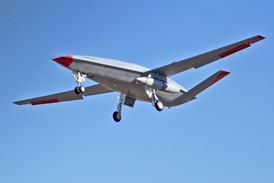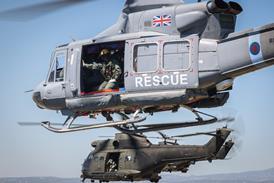The ELTA/IAI Boeing 737 displayed at Le Bourget is fitted with the company's Flight Guard Civil Aviation Missile Protection System.
With a growing SAM threat to civil airliners, and in the wake of the attempt to shoot down an Arkia Boeing 757 in Kenya, ELTA is working to bring its tried and tested military defensive anti missile system to the civil airline market.
The company believes that the range and altitude capability of modern man-portable SAMs threatens a zone of 25 miles (40km) and up to about 12,000ft (3,660m) around any airport.
It is, says the company, impossible to defend against SAM attacks on the ground, since these highly portable systems can be easily hidden, and can be launched from vehicles, boats, or densely populated metropolitan areas.
Platform
ELTA's anti-missile system is in-service on more than 150 platforms including the F-16 fighter, and on An-32, Fokker 60 and Fokker 70, C160 Transall, C-130 Hercules, Boeing 707 and Gulfstream transport aircraft. The system has also been used on a range of helicopters, including the Sikorsky UH-60, and the company's proud boast is that no aircraft equipped with the system has ever been shot down, though many have been engaged.
On one occasion, a formation of Sri Lankan helicopters was fired upon by five SAMs. The three Mi-17s in the formation were fitted with ELTA's system, and escaped unscathed (saving 90 troops and 12 crew) but the escorting Mi-24 had not been fitted with the system, and was downed.
The system is based around six miniaturised ELTA pulse-Doppler sensors, which can easily be located to give all round coverage. On the Boeing 737 demonstrator at Le Bourget four are fitted below the nose radome, with two more further aft on the forward fuselage and two on the tailcone. These are used to automatically trigger the release of IR decoy flares in the event of any attack. The system gives greater than 99% probability of missile detection, and has a very low false alarm rate.
Flare dispensers would usually be fitted in the wing-fuselage fairing as this does not involve penetrating the aircraft's pressure hull, and gives a minimum drag configuration. Installation is simple and quick, and does not require aircraft to be withdrawn from service for an extended period.
Secured
The advanced Israel Military Industries flares used by the system burn for only about 2-3 seconds, and leave only a gas with no solid or liquid residue. There is no danger of the flares hitting the ground while still alight, and they are packed in an easily secured and self-contained box which requires minimal maintenance.
This leads IAI and ELTA to hope that the system will be able to gain civil certification from Israel's civil aviation authority by the end of the year, and the US FAA is shadowing the process.
IAI hope that it will be the first in the civil market with a real, working anti missile system, and hopes to gain certification at the end of the year. The Israeli Government has already directed that all Israeli airliners should be fitted with the system.
Flight Guard is understood to cost 'significantly' less than $1 million per system and that series production could reduce the cost to around $500,000 per aircraft.
Source: Flight Daily News
















